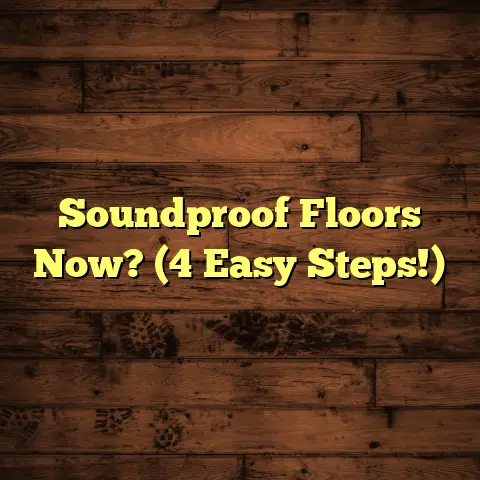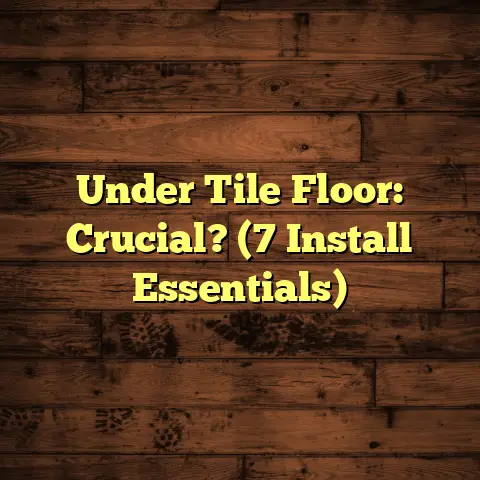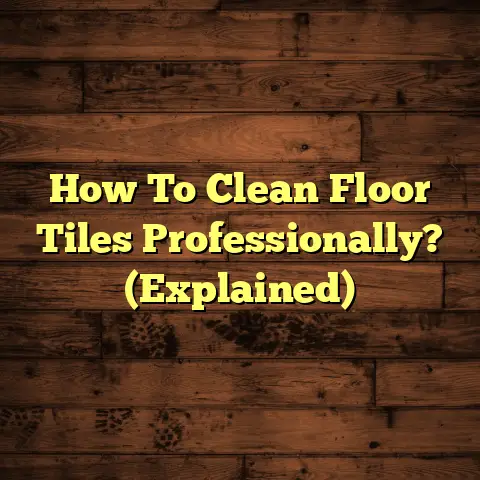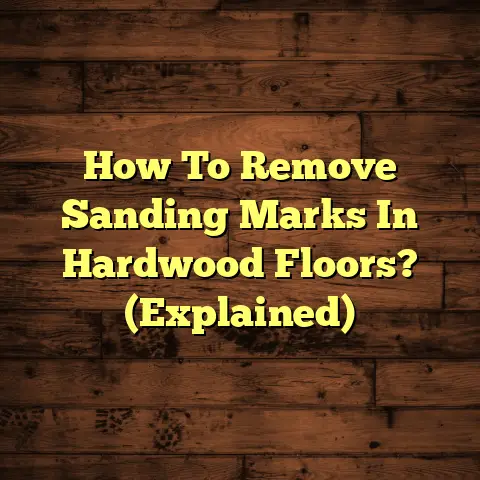Concrete Floor Polishing Cost? (6 Surprise Fees!)
Did you know that polished concrete is becoming the rockstar of flooring choices?
According to a recent study by the National Association of Home Builders, over 30% of new residential constructions are now rocking polished concrete floors!
That’s a huge jump, right?
And I’m here to tell you, from my years in the flooring trenches, it’s no surprise.
Polished concrete looks amazing, lasts forever, and is super easy to clean. But, like any home improvement project, understanding the costs involved is crucial.
Trust me, I’ve seen it all, and I want to help you avoid some common (and costly) pitfalls when it comes to polishing your concrete floors. Let’s dive in!
Overview of Concrete Floor Polishing
So, what exactly is polished concrete?
Simply put, it’s concrete that’s been mechanically ground, honed, and polished with specialized equipment and diamond abrasives. Think of it like sanding wood, but on a much larger and tougher scale.
The result?
A smooth, glossy surface that’s not only beautiful but also incredibly durable.
Here’s why people are going crazy for it:
-
Aesthetics: From sleek modern looks to rustic industrial vibes, polished concrete can be customized to fit any style.
-
Durability: This stuff is tough! It can withstand heavy foot traffic, making it perfect for both homes and businesses.
-
Low Maintenance: Say goodbye to endless waxing and polishing. Polished concrete is easy to clean and requires minimal upkeep.
You’ll find polished concrete everywhere these days:
-
Residential: Kitchens, living rooms, basements, garages – you name it!
-
Commercial: Retail stores, warehouses, restaurants, offices – it’s a popular choice for high-traffic areas.
-
Industrial: Manufacturing plants, factories, and other industrial spaces benefit from its durability and resistance to wear and tear.
The trend is definitely growing, and for good reason. It’s a cost-effective, long-lasting, and stylish flooring solution. But let’s get down to brass tacks: how much does it really cost?
Basic Cost Breakdown
Alright, let’s talk numbers.
The average cost of concrete floor polishing can vary quite a bit depending on several factors.
Generally, you can expect to pay anywhere from $3 to $12 per square foot.
But that’s just a ballpark figure!
Here’s what influences the price:
-
Size of the area: Larger spaces often qualify for discounts, but smaller areas might have a higher per-square-foot cost.
-
Condition of the concrete: Is your concrete cracked, stained, or uneven? Repairs and preparation will add to the overall cost.
-
Level of polish: Do you want a basic grind and seal, or a full, high-gloss polish? The more steps involved, the higher the price.
Here’s a more detailed breakdown of typical price ranges:
| Polishing Level | Description | Price per Square Foot |
|---|---|---|
| Grind and Seal | A basic option that involves grinding the surface and applying a sealant. | $3 – $6 |
| Polished Concrete (Basic) | Grinding and polishing to a matte finish. | $5 – $8 |
| Polished Concrete (Mid-Grade) | More extensive grinding and polishing to a semi-gloss finish. | $7 – $10 |
| Polished Concrete (High-End) | Extensive grinding and polishing to a high-gloss, mirror-like finish. | $9 – $12 |
| Dyed/Stained Concrete | Adding color or stain to the concrete before polishing. | $8 – $15 |
| Epoxy Coating | Applying an epoxy coating over the concrete for added protection and aesthetics. | $6 – $12 |
Keep in mind that these are just averages.
The best way to get an accurate estimate is to get quotes from several reputable flooring contractors in your area.
But before you do that, let’s talk about those pesky surprise fees that can sneak up on you and blow your budget.
Surprise Fees
Okay, this is where things get real.
I’ve seen so many homeowners get blindsided by unexpected costs when polishing their concrete floors. It’s not fun for anyone!
That’s why I’m here to arm you with the knowledge you need to avoid these pitfalls.
Here are six common surprise fees to watch out for:
1. Preparation Costs
This is the big one.
Proper surface preparation is absolutely essential for a successful concrete polishing project. If your concrete isn’t properly prepped, the final result will be subpar, and you’ll likely end up spending more money in the long run.
Here’s what preparation typically involves:
-
Cleaning: Removing dirt, dust, debris, and any existing coatings or sealants.
-
Crack Repair: Filling cracks and patching damaged areas to create a smooth, even surface.
-
Leveling: Grinding down high spots and filling in low spots to ensure a level floor.
Why these costs can be a surprise:
Many contractors don’t include a detailed breakdown of preparation costs in their initial quotes. They might give you a low price per square foot, but then hit you with a hefty bill for preparation work later on.
Example:
Let’s say you have a 500-square-foot basement that needs polishing. You get a quote for $4 per square foot, which seems like a great deal.
But then, the contractor tells you that the concrete needs extensive crack repair and leveling, which will cost an additional $1,000!
That’s an extra $2 per square foot, bringing the total cost to $6 per square foot.
How to avoid this:
-
Get a detailed quote: Make sure the quote includes a breakdown of all preparation costs.
-
Ask about contingencies: Ask the contractor what happens if they encounter unexpected problems during preparation.
-
Get multiple quotes: Compare quotes from several contractors to see who offers the most comprehensive and transparent pricing.
2. Sealing and Coating Fees
Wait a minute, isn’t polishing enough?
Well, not always.
While polishing does create a smooth, dense surface, it doesn’t necessarily make the concrete completely impervious to stains and moisture.
That’s where sealing and coating come in.
Sealing:
Applying a sealant helps to protect the concrete from spills, stains, and water damage. It also enhances the shine and makes the floor easier to clean.
Coating:
Applying a coating, such as epoxy, provides an extra layer of protection and can also add color and texture to the floor.
Why these costs can be a surprise:
Some contractors don’t include sealing or coating in their base price. They might assume that you don’t want it, or they might try to upsell you on it later.
Example:
You get your concrete floors polished, and they look great! But a few weeks later, you spill some red wine on the floor, and it stains the concrete.
You call the contractor, and they tell you that you should have sealed the floor to prevent staining, which would have cost an additional $1 per square foot.
How to avoid this:
-
Ask about sealing and coating options: Discuss the pros and cons of each option with your contractor.
-
Get a price for sealing and coating: Make sure the quote includes the cost of sealing or coating, if desired.
-
Understand the benefits: Sealing and coating can extend the life of your polished concrete floors and protect them from damage.
3. Coloring and Staining Charges
Want to add some personality to your concrete floors?
Coloring and staining can transform plain gray concrete into a work of art.
Coloring:
Adding color to the concrete mix before it’s poured.
Staining:
Applying a stain to the surface of the concrete after it’s been polished.
Why these costs can be a surprise:
Coloring and staining can add a significant amount to the overall cost of your project, especially if you choose a custom color or a complex staining pattern.
Example:
You want to match your concrete floors to your existing decor, so you choose a custom stain color.
The contractor tells you that the custom stain will cost an additional $3 per square foot!
How to avoid this:
-
Ask about coloring and staining options: Discuss the different options and their associated costs with your contractor.
-
Get samples: Ask to see samples of different colors and stains before making a decision.
-
Consider the long-term cost: Colored and stained concrete can add value to your home, but it’s important to factor in the additional cost.
4. Floor Removal and Disposal Fees
What if you already have flooring installed?
In some cases, you’ll need to remove the existing flooring before you can polish the concrete underneath.
Why these costs can be a surprise:
Removing old flooring can be a time-consuming and labor-intensive process, and disposal fees can also add up.
Example:
You have old tile flooring in your kitchen that you want to remove before polishing the concrete.
The contractor tells you that removing the tile and disposing of it will cost an additional $2 per square foot!
How to avoid this:
-
Factor in removal costs: If you need to remove existing flooring, make sure to include the cost of removal and disposal in your budget.
-
Ask about DIY options: You might be able to save money by removing the flooring yourself.
-
Consider the disposal fees: Disposal fees can vary depending on the type of flooring and your location.
5. Repairs and Maintenance Costs
Even concrete isn’t indestructible.
Over time, concrete floors can develop cracks, chips, and other damage.
Why these costs can be a surprise:
Repairing damaged concrete can be costly, especially if the damage is extensive.
Example:
You discover a large crack in your concrete floor that needs to be repaired before polishing.
The contractor tells you that repairing the crack will cost an additional $500!
How to avoid this:
-
Inspect your floors regularly: Look for signs of damage, such as cracks, chips, and stains.
-
Repair damage promptly: The sooner you repair damage, the less it will cost.
-
Factor in maintenance costs: Polished concrete floors require minimal maintenance, but it’s important to clean them regularly and reseal them every few years.
6. Additional Labor Fees
The more complex the job, the more labor it requires.
Why these costs can be a surprise:
Intricate designs, large spaces, and difficult access can all increase labor costs.
Example:
You want to create a decorative pattern in your polished concrete floors.
The contractor tells you that the intricate design will require additional labor, which will cost an extra $2 per square foot.
How to avoid this:
-
Keep it simple: Simple designs and straightforward layouts will minimize labor costs.
-
Provide easy access: Make sure the contractors have easy access to the work area.
-
Get a detailed labor estimate: Ask the contractor for a detailed breakdown of labor costs.
Real-Life Examples and Case Studies
Let’s get real with some stories from the field.
I’ve seen firsthand how these surprise fees can impact homeowners.
Case Study 1: The Basement Renovation Blunder
A homeowner in Denver was thrilled to renovate their basement with polished concrete.
They got a quote for $4 per square foot, thinking they were getting a steal.
But once the project started, they were hit with a $1,500 bill for crack repairs and leveling.
Turns out, the original quote didn’t include any preparation costs!
Case Study 2: The Staining Surprise
A restaurant owner in Austin decided to polish their concrete floors for a modern look.
They chose a beautiful stain color, but they didn’t realize that the stain would require a special sealant to prevent fading.
The sealant added an extra $2 per square foot to the overall cost.
Personal Story:
I once worked on a project where the homeowner insisted on removing the existing tile flooring themselves to save money.
Unfortunately, they damaged the concrete subfloor in the process, which ended up costing them even more to repair!
The lesson here is that it’s always best to leave certain tasks to the professionals.
These examples highlight the importance of doing your research, getting detailed quotes, and being prepared for the unexpected.
Conclusion
Alright, we’ve covered a lot of ground!
Concrete floor polishing can be a fantastic way to upgrade your home or business.
It’s durable, stylish, and easy to maintain.
But it’s also important to be aware of the potential surprise fees that can inflate the overall cost.
Here’s a quick recap:
-
Preparation Costs: Don’t underestimate the importance of proper surface preparation.
-
Sealing and Coating Fees: Protect your investment with a sealant or coating.
-
Coloring and Staining Charges: Add personality to your floors, but be aware of the extra cost.
-
Floor Removal and Disposal Fees: Factor in the cost of removing existing flooring.
-
Repairs and Maintenance Costs: Address damage promptly to prevent further problems.
-
Additional Labor Fees: Keep it simple to minimize labor costs.
By being aware of these potential surprise fees, you can avoid budget-busting surprises and ensure a smooth and successful concrete floor polishing project.
Remember, knowledge is power!
Do your research, get multiple quotes, and ask lots of questions.
And if you ever need any help, don’t hesitate to reach out to a qualified flooring contractor.
Good luck with your project, and happy polishing!





